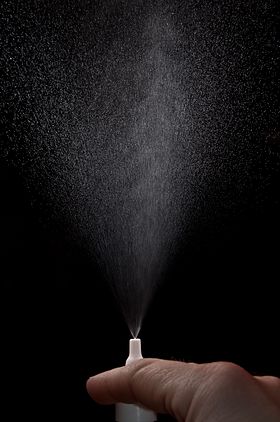Nasal spray
This articleneeds morereliable medical referencesforverificationor relies too heavily onprimary sources.(November 2017) |  |
| Nasal spray | |
|---|---|
 Actuation of a nasalspray bottle,used to deliver medication via thenostrils | |
| Other names | nasal drops |
Nasal spraysare used to deliver medicationslocallyin thenasal cavitiesorsystemically.They are used locally for conditions such asnasal congestionandallergic rhinitis.In some situations, thenasal delivery routeis preferred for systemic therapy because it provides an agreeable alternative to injection or pills. Substances can be assimilated extremely quickly and directly through the nose.[1][unreliable medical source?]Many pharmaceutical drugs exist as nasal sprays for systemic administration (e.g.sedative-analgesics, treatments formigraine,osteoporosisandnausea). Other applications includehormone replacement therapy,treatment ofAlzheimer's diseaseandParkinson's disease.Nasal sprays are seen as a more efficient way of transporting drugs with potential use in crossing the blood–brain barrier.

Antihistamines
[edit]Antihistamineswork by competing for receptor sites to block the function of histamine, thereby reducing the inflammatory effect. Antihistamine nasal sprays include:
- Azelastinehydrochloride
- Levocabastinehydrochloride
- Olopatadinehydrochloride
Corticosteroids
[edit]Corticosteroidnasal sprays can be used to relieve the symptoms ofsinusitis,hay fever,allergic rhinitis and non-allergic (perennial) rhinitis. They can reduce inflammation and histamine production in the nasal passages, and have been shown to relievenasal congestion,runny nose,itchy nose andsneezing.[2]Side effects may includeheadaches,nauseaandnose bleeds.[citation needed]Corticosteroid nasal sprays include:
- Beclomethasone dipropionate
- Budesonide
- Ciclesonide
- Flunisolide
- Fluticasone furoate
- Fluticasone propionate
- Mometasone
- Triamcinolone acetonide
Saline
[edit]Salinesprays are typically non medicated. A mist ofsaline solutioncontainingsodium chlorideis delivered to help moisturize dry or irritated nostrils. This is a form ofnasal irrigation.They can also relieve nasal congestion and remove airborne irritants such as pollen and dust thereby providing sinus allergy relief.
Three types of nasal sprays preparations of sodium chloride are available including hypertonic (3% sodium chloride orsea water), isotonic (0.9% sodium chloride) and hypotonic (0.65% sodium chloride). Isotonic solutions have the same salt concentration as the human body, whereas hypertonic solutions have a higher salt content and hypotonic solutions have a lower salt content. Isotonic saline nasal sprays are commonly used in infants and children to wash out the thickmucusfrom the nose in case ofallergic rhinitis.Hypertonic solutions may be more useful at drawing moisture from themucous membraneand relieving nasal congestion.
Natural nasal sprays that include chemical complexes derived from plant sources such asginger,capsaicinandtea-tree oilare also available. There is however no trial-verified evidence that they have a measurable effect on symptoms.
Topical decongestants
[edit]Decongestantnasal sprays are availableover-the-counterin many countries. They work to very quickly open up nasal passages by constricting blood vessels in the lining of the nose. Prolonged use of these types of sprays can damage the delicate mucous membranes in the nose. This causes increased inflammation, an effect known asrhinitis medicamentosaor therebound effect.Decongestant nasal sprays are advised for short-term use only, preferably 5 to 7 days at maximum. Some doctors advise to use them 3 days at maximum. A recent clinical trial has shown that a corticosteroid nasal spray may be useful in reversing this condition.[3]Topical nasal decongestants include:
Allergy combinations
[edit]Combination use of two medications as nasal spray preparation has been frequently prescribed by doctors.[medical citation needed]
List of some combination nasal sprays:
- Azelastinetogether withfluticasone propionate(brand names including Dymista)[4]
- Xylometazolinetogether withcromoglicic acid
In some countries, Dymista is marketed byViatrisafter Upjohn merged with Mylan to create Viatris.[5][6]
References
[edit]- ^"Breakthrough: Nasal Spray May Soon Replace Pills for Delivering Drugs to the Brain".Science Daily.Science Daily. 21 May 2014.Retrieved30 March2015.
- ^Rizzo MC, Solé D, Naspitz CK (2007)."Corticosteroids (inhaled and/or intranasal) in the treatment of respiratory allergy in children: safety vs. efficacy".Allergologia et Immunopathologia.35(5): 197–208.doi:10.1157/13110315.PMID17923074.S2CID13622570.
- ^Vaidyanathan S, Williamson P, Clearie K, Kahn F, Lipworth B (July 2010). "Fluticasone reverses oxymetazoline-induced tachyphylaxis of response and rebound congestion".American Journal of Respiratory and Critical Care Medicine.182(1): 19–24.doi:10.1164/rccm.200911-1701OC.PMID20203244.
- ^"Dymista/Dylastine (Viatris Pty Ltd)".Therapeutic Goods Administration (TGA).1 July 2024.Retrieved8 July2024.
- ^"Pfizer Completes Transaction to Combine Its Upjohn Business with Mylan".Pfizer. 16 November 2020.Retrieved17 June2024– via Business Wire.
- ^"Brands".Viatris.16 November 2020.Retrieved17 June2024.
External links
[edit] Media related toNasal spraysat Wikimedia Commons
Media related toNasal spraysat Wikimedia Commons






